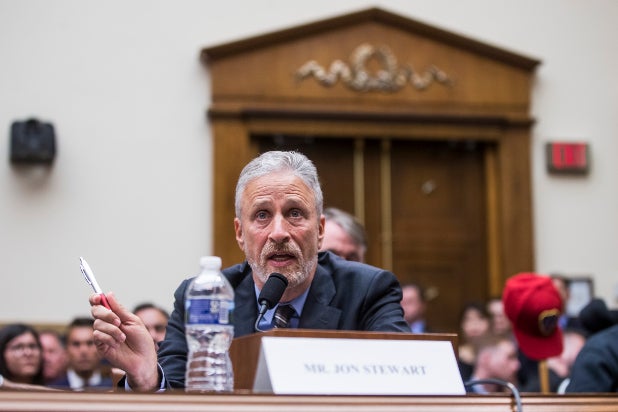Stewart appealed to Congress on behalf of 9/11 first responders last year, asking the lawmaking body to make a victim compensation fund permanent
Getty
Many Americans shared their stories of 9/11 Friday — but some also shared memories from 2019, when former late-night host Jon Stewart emotionally appealed to Congress on behalf of first responders.
In a fiery speech outlining why he felt a victim compensation fund should be made permanent, Stewart was so animated and sincere, he went instantly viral and brought Americans to tears.
Ultimately, in July 2019, a month after the comedian and former “Daily Show” host gave his impassioned testimony, the Senate passed legislation that extended funding to victims of the 9/11 terrorist attacks.
“Your indifference cost these men and women their most valuable commodity: Time,” Stewart said during his July 2019 speech, lambasting the mostly-empty committee hearing. “What an incredible metaphor this room is for the entire process that getting health care and benefits for 9/11 first responders has come to. Behind me, a filled room of 9/11 first responders and in front of me, a nearly empty Congress. Sick and dying, they brought themselves down here to speak. To no one.”
Stewart continued: “Shameful. It’s an embarrassment to the country, and it is a stain on this institution. And you should be ashamed of yourselves for those that aren’t here, but you won’t be, because accountability doesn’t appear to be something that occurs in this chamber.”
The address was passed around Twitter again Friday during commemorations of the 19-year anniversary of the attacks, as was Stewart’s original first “Daily Show” monologue following the 2001 event. Observers urged viewers to “watch every second” of the testimony.
See it below:
9/11: A Brief History Of The World Trade Center In Film (Videos)
- Before their tragic destruction in the September 11 attacks, the World Trade Center’s Twin Towers were among the most recognizable buildings in New York City, which also made them a frequent shooting spot for movies centered in the Big Apple. Here’s a look back at the WTC’s appearances in movies, as well as some of the most famous callbacks to the Twin Towers after they fell.
- In 1973, shortly before the completion of the towers, the cast of “Godspell” danced on the roof during the finale of the song “All for the Best.” The song ends with a full shot of the World Trade Center, one of the first presented on film.
- In the 1976 remake of “King Kong,” the titular ape scales the World Trade Center instead of the Empire State Building in a nod to the Towers’ new status as the tallest buildings in NYC.
- The World Trade Center Plaza between the towers was used as Emerald City in “The Wiz.” The scene was not completed as intended due to the intense winds that flowed between the towers.
- One of Tom Hanks’ earliest roles was in the 1982 TV movie “Mazes and Monsters,” in which he plays a young man with delusions that he is a RPG character. His fantasy takes him to the top of the World Trade Center… where he plans to fly off.
- “Working Girl,” the Melanie Griffith film about a Staten Island woman who works her way up the corporate ladder, takes place in 7 World Trade Center, a building adjacent to the towers that was also destroyed in the 9/11 attacks. Several scenes were shot in the WTC Plaza and in the lobby of the building.
- Brian De Palma’s infamous “Bonfire of the Vanities” opens with a long shot of a drunk Peter Fallow (Bruce Willis) being escorted through the basement of the World Trade Center. The opening scene is done in a single continuous shot that lasts almost five minutes.
- In “Home Alone 2: Lost In New York,” Kevin McAllister goes on a sightseeing trip through the Big Apple that ends with him taking pictures of the city from the WTC’s observation deck.
- The World Trade Center is one of many NYC landmarks that is destroyed by a meteor shower in the 1998 film “Armageddon.” Shots of the towers getting hit were cut out of TV rebroadcasts of the film in the months following 9/11.
- The 1998 documentary “The Cruise” follows NYC tour guide Timothy “Speed” Levitch and explores his off-beat take on the city. He encourages a tourist to go to the World Trade Center and spin between the buildings before looking up to create the illusion that the towers are falling down on her. Later in the film, he goes to the towers and does this himself.
- After the 9/11 attacks, Martin Scorsese chose to include the World Trade Center in the ending of “Gangs of New York,” which shows the evolution of the New York skyline.
- 9/11 has an impact on Spike Lee’s “25th Hour.” Although the film was written prior to the attacks, Lee chose to make it a major part of his depiction of New York. The film opens with a shot of the two columns of light that stood as a memorial to the World Trade Center, and several shots show Edward Norton wandering past memorials to the victims and past Ground Zero, where bulldozers are removing the remains of the buildings.
- Perhaps the most famous usage of the World Trade Center post-9/11 is in the final shot of “Munich.” Many critics believe it is Steven Spielberg’s attempt to connect the violence that spawned by the attempts to assassinate those responsible for the 1972 Munich Olympics attacks to the violence created by the War on Terror. In a 2006 interview with German news source, Der Spiegel, Spielberg denied that he was making that connection, saying that he included the World Trade Center because it was still standing at the time the story was set in.
Before September 11, the World Trade Center was used often by film crews in New York
Source: Read Full Article

